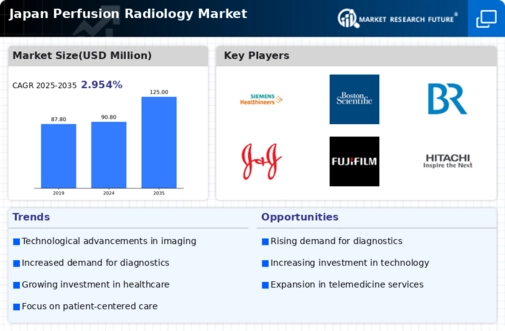Government Initiatives and Funding
Government initiatives aimed at improving healthcare infrastructure in Japan are significantly impacting the perfusion radiology market. The Japanese government has allocated substantial funding to enhance medical imaging facilities and promote research in advanced imaging techniques. For instance, the Ministry of Health, Labour and Welfare has introduced programs to support the adoption of cutting-edge imaging technologies in hospitals. This financial backing is expected to stimulate growth in the perfusion radiology market, as healthcare providers are more likely to invest in new technologies with government support. The market could see an increase in funding by approximately 15% over the next few years, facilitating advancements in diagnostic capabilities.
Growing Awareness of Early Diagnosis
There is a growing awareness among the Japanese population regarding the importance of early diagnosis in managing health conditions, particularly in relation to cardiovascular diseases. This awareness is driving demand for advanced imaging techniques, including those offered by the perfusion radiology market. Educational campaigns and health initiatives are encouraging individuals to seek regular check-ups and screenings, thereby increasing the utilization of perfusion imaging. As a result, healthcare providers are likely to expand their offerings in this area, leading to a projected market growth of around 10% annually. This trend reflects a shift towards proactive healthcare management, which is essential for improving patient outcomes.
Technological Integration in Healthcare
The integration of advanced technologies such as artificial intelligence (AI) and machine learning into healthcare systems is transforming the perfusion radiology market. In Japan, hospitals are increasingly adopting AI-driven imaging solutions to improve diagnostic accuracy and efficiency. These technologies enable radiologists to analyze perfusion data more effectively, leading to quicker and more accurate diagnoses. The market for AI in medical imaging in Japan is projected to reach $1 billion by 2026, indicating a robust growth trajectory. This technological evolution not only enhances the capabilities of perfusion radiology but also aligns with the broader trend of digital transformation in healthcare, making it a crucial driver for market expansion.
Rising Incidence of Cardiovascular Diseases
The increasing prevalence of cardiovascular diseases in Japan is a primary driver for the perfusion radiology market. As the population ages, the demand for advanced imaging techniques to diagnose and monitor heart conditions rises. According to recent health statistics, cardiovascular diseases account for approximately 30% of all deaths in Japan, highlighting the urgent need for effective diagnostic tools. This trend is likely to propel investments in perfusion radiology technologies, as healthcare providers seek to enhance patient outcomes through precise imaging. The perfusion radiology market is expected to benefit from this growing focus on cardiovascular health, with an anticipated growth rate of approximately 8% per year over the next five years.
Aging Population and Increased Healthcare Demand
Japan's aging population is a significant driver of the perfusion radiology market. As the demographic shifts towards an older population, there is a corresponding increase in the demand for healthcare services, particularly in diagnostic imaging. Older adults are more susceptible to various health issues, including cardiovascular diseases, necessitating advanced imaging solutions for effective diagnosis and treatment. The Japanese population aged 65+ is expected to reach 30% by 2030, further intensifying the need for perfusion radiology services. This demographic trend is likely to propel market growth, with an estimated increase of 12% in demand for perfusion imaging technologies over the next five years.




















Leave a Comment